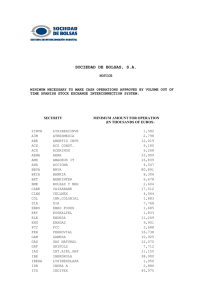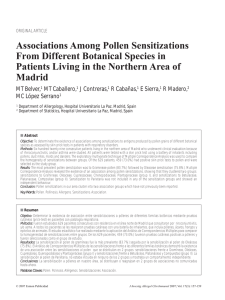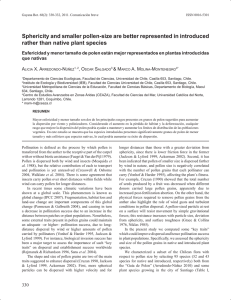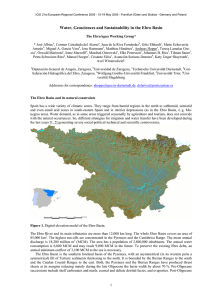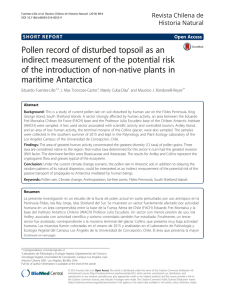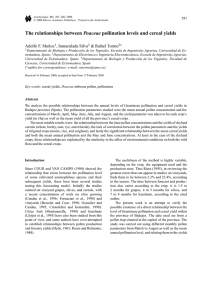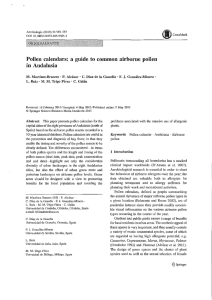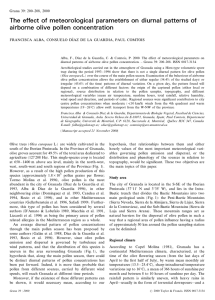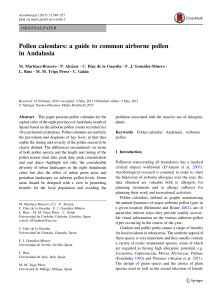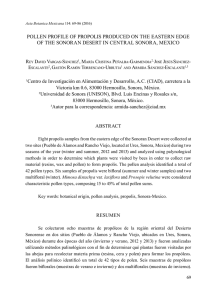02-WAS THE - Universidad de Murcia
Anuncio
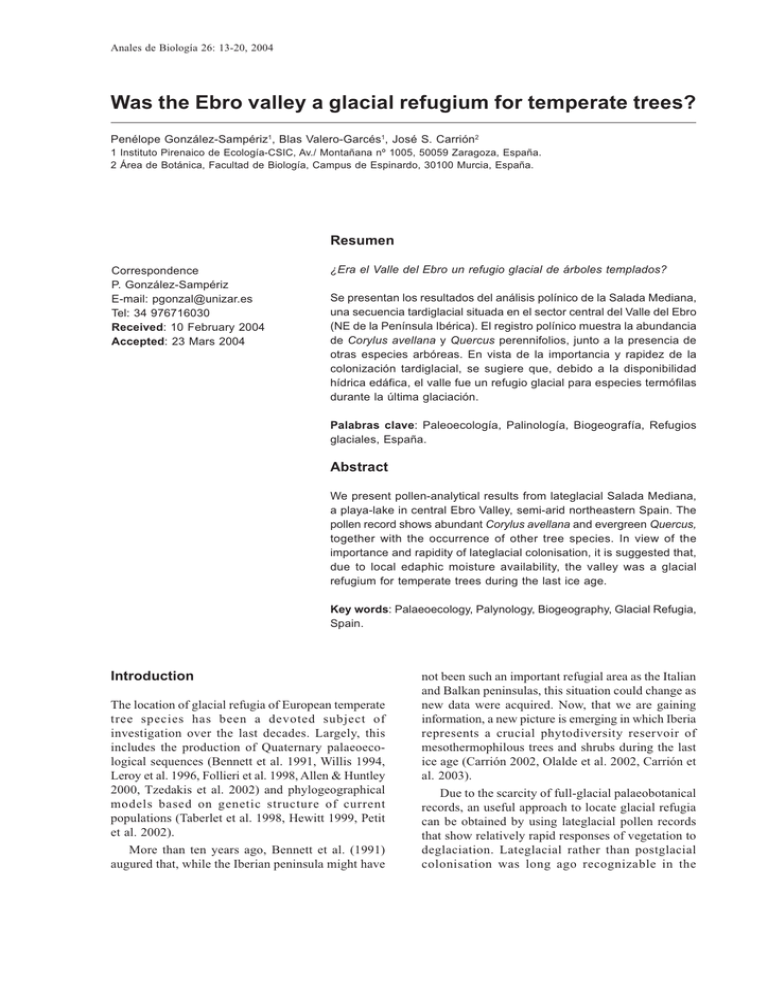
Anales de Biología 26: 13-20, 2004 Was the Ebro valley a glacial refugium for temperate trees? Penélope González-Sampériz1, Blas Valero-Garcés1, José S. Carrión2 1 Instituto Pirenaico de Ecología-CSIC, Av./ Montañana nº 1005, 50059 Zaragoza, España. 2 Área de Botánica, Facultad de Biología, Campus de Espinardo, 30100 Murcia, España. Resumen Correspondence P. González-Sampériz E-mail: pgonzal@unizar.es Tel: 34 976716030 Received: 10 February 2004 Accepted: 23 Mars 2004 ¿Era el Valle del Ebro un refugio glacial de árboles templados? Se presentan los resultados del análisis polínico de la Salada Mediana, una secuencia tardiglacial situada en el sector central del Valle del Ebro (NE de la Península Ibérica). El registro polínico muestra la abundancia de Corylus avellana y Quercus perennifolios, junto a la presencia de otras especies arbóreas. En vista de la importancia y rapidez de la colonización tardiglacial, se sugiere que, debido a la disponibilidad hídrica edáfica, el valle fue un refugio glacial para especies termófilas durante la última glaciación. Palabras clave: Paleoecología, Palinología, Biogeografía, Refugios glaciales, España. Abstract We present pollen-analytical results from lateglacial Salada Mediana, a playa-lake in central Ebro Valley, semi-arid northeastern Spain. The pollen record shows abundant Corylus avellana and evergreen Quercus, together with the occurrence of other tree species. In view of the importance and rapidity of lateglacial colonisation, it is suggested that, due to local edaphic moisture availability, the valley was a glacial refugium for temperate trees during the last ice age. Key words: Palaeoecology, Palynology, Biogeography, Glacial Refugia, Spain. Introduction The location of glacial refugia of European temperate tree species has been a devoted subject of investigation over the last decades. Largely, this includes the production of Quaternary palaeoecological sequences (Bennett et al. 1991, Willis 1994, Leroy et al. 1996, Follieri et al. 1998, Allen & Huntley 2000, Tzedakis et al. 2002) and phylogeographical models based on genetic structure of current populations (Taberlet et al. 1998, Hewitt 1999, Petit et al. 2002). More than ten years ago, Bennett et al. (1991) augured that, while the Iberian peninsula might have not been such an important refugial area as the Italian and Balkan peninsulas, this situation could change as new data were acquired. Now, that we are gaining information, a new picture is emerging in which Iberia represents a crucial phytodiversity reservoir of mesothermophilous trees and shrubs during the last ice age (Carrión 2002, Olalde et al. 2002, Carrión et al. 2003). Due to the scarcity of full-glacial palaeobotanical records, an useful approach to locate glacial refugia can be obtained by using lateglacial pollen records that show relatively rapid responses of vegetation to deglaciation. Lateglacial rather than postglacial colonisation was long ago recognizable in the 14 P. González-Sampériz et al. continental Andalusian site of Padul (Pons & Reille 1988), and has been now made clear in mid altitudes of the eastern Betic Mountains (Carrión 2002). However, this phenomenon is not exclusive from southern latitudes and, at least for Corylus and Quercus, can be perceived in continental pollen sequences of the Pyrenees (Jalut et al. 1992, Montserrat 1992), pre-Pyrenees (Pérez-Obiol & Julià 1994), Iberian system and Meseta (Peñalba 1994, Stevenson 2000). Palynological findings join to studies of fossil macrocharcoal (Uzquiano 1992) and palaeontological data to support the idea by Peñalba (1994) that northern Iberia was covered by a patched network of tree populations during the last glacial age (Carrión et al. 2003). Although the hypothesis of long-distance migration of European taxa may be applicable for some species (Petit et al. 2002), it is yet possible that this picture have rather arisen from the fragmentary character of databases (Brewer et al. 2002) than from the exclussive maintenance of trees in the south. Another crucial issue deals with altitudinal location. More or less explicitly, most commentators tend to accept Bennett et al. (1991)´s postulation that refugia would have occurred principally in midaltitude mountain positions (Tzedakis 1994, Willis 1994, Tzedakis et al. 1997, 2002) and nearby the sea (Turner & Hannon 1988, Brewer et al. 2002, Carrión et al. 2003), especially where local topography permitted rapid altitudinal displacements as response to climatic changes. Given the physiography of Iberia, this may well be the case for most of the region, but we should keep the model open to new findings. Here we bring new data to this debate. The Salada Mediana pollen record shows abundant Corylus avellana and evergreen Quercus, together with the occurrence of other tree species during the Lateglacial and Early Holocene. The significance of these findings rely on the geographic, topographic, and climatic features of the study site. The Salada Mediana lies within the central Ebro Valley in the northeastern plain of Iberia under a semi-arid climatic regime. From a neontological perspective, a region indeed hardly conceivable as suitable refugium for mesophilous woods. Anales de Biología 26, 2004 (Gutiérrez & Peña 1994). The climate is continental Mediterranean with hot summers, cold dry winters, low annual rainfall (ca. 300 mm) and mean temperatures of 24.2ºC and 6.4ºC in July (warmest month) and January (coldest month) respectively (Cuadrat 1999). Climatic aridity and local endorheism have favoured the development of small saline lakes like Salada Mediana. Most are ephemeral playa-lake systems associated to karstic or aeolian processes on Tertiary evaporitic units. Locally, the margins of Salada Mediana playa-lake are covered by halophytic plant communities. Regional landscape is steppic, with vegetation cover below 50% (Braun-Blanquet & de Bolòs 1957), although it has been traditionally cultivated. Open forest stands of Pinus halepensis, Quercus coccifera and Juniperus thurifera interrupt this steppic landscape, while deciduous trees are mainly restricted to inaccessible gorges. Relictic Corylus can be only found in the north-western but not in the central areas of the Ebro Valley (Blanco et al. 1997). Methods Two 165-cm long sediment cores were raised with a modified Livingstone corer in the summer of 1996 when the playa-lake was dry. Sedimentary facies were identified based on colour, lithology and sedimentological structures. One long core was photographed, described and sampled for pollen analysis, organic matter and carbonate content. Isotopic composition of cyanobacterial mats and halophytic plants have been studied previously (Valero-Garcés et al. 2000a, b). Pollen grains and spores were extracted in the laboratory by the classic chemical method (Moore et al. 1991) using Thoulet liquid for palynomorph concentration (Dupré 1992) and Lycopodium clavatum spore tablets (Stockmarr 1971) to calculate pollen concentration. A pollen diagram was constructed using Tilia, TiliaGraph and CorelDraw software. Chronological control is based on six AMS 14 C dates (Table 1) from pollen concentrates (ValeroGarcés et al. 2000a). Physical Setting Results and Discussion The Salada Mediana (41º 30' 10'’ N, 0º 44' W, 350 m a.s.l.) is a playa-lake lying in the Ebro River Basin (Fig. 1), within the northernmost European region with semi-arid climate. The basin is surrounded by the Pyrenees to the north, the Iberian Range to the southwest and the Catalonian Ranges to the east In spite of the caveats of the Salada Mediana chronology, it is clear that most of the sequence below 25 cm depth is of lateglacial age (Middle and Lower sections of the core). A combination of several factors may account for the age inversions. The δ 13C values (around –25‰ PDB) do not indicate any significant Anales de Biología 26, 2004 Ebro valley a glacial refugium 15 Figure 1. Location map of Salada Mediana in northeastern Spain (Ebro Basin). Depth (cm) 4.5-5.5 28-29.5 50-51 89.5-91 132-135.5 146.5-148 Material Weight (mg) Pollen Pollen Pollen Pollen Pollen Pollen 27.23 0.97 3.3 0.64 0.94 0.89 14 C yr B.P. Lab number 1710 + 35 12,400 + 110 10,850 + 200 10,350 + 65 17,300 + 130 11,250 + 60 OS–16717 NSRL–10586 OS-14932 OS-22658 NRSL-10588 NRSL-10589 Table 1. AMS 14C dates of Salada Mediana sediment core (Valero-Garcés et al. 2000a). presence of lacustrine organic matter in the dated samples and pollen and sedimentological data do not suggest significant reworking and contamination by old detrital carbon in these levels. However, a reservoir effect cannot be ruled out completely in some samples (Valero-Garcés et al. 2000a). The reservoir effect is not constant for a specific lake, and it depends on water level (Geyh et al. 1998). The date of 17.300 + 130 14C yr B.P. at 132-135.5 cm depth could be affected by hard-water effect due to the presence of aquatic pollen (Myriophyllum) in the sample. In spite of the chronological uncertainties, the study suggest a Lateglacial sequence and a historic section (up to 25 cm depth) with a long hiatus between (Valero-Garcés et al. 2000a). A striking feature of the Salada Mediana pollen diagram is the relatively high AP values (Fig. 2), at least if the reconstructed vegetation is compared with 16 P. González-Sampériz et al. Anales de Biología 26, 2004 Figure 2. Pollen diagram of Salada Mediana with most representative taxa. Pinus and Chenopodiaceae have been excluded from the pollen sum and the calculation of the rest of taxa percentages. Mesophilous taxa are integrated by Quercus faginea type, Betula, Alnus, Salix, Ulmus and Juglans. Thermophilous taxa are integrated by Olea-Phyllirea, Pistacia, Rhamnus, Myrtus, Ceratonia and Tamarix. Anales de Biología 26, 2004 Ebro valley a glacial refugium the present-day steppic situation. In the diagram we can observe the percentages representation starting from a pollen sum without Pinus and Chenopodiaceae. It is particularly worth mentioning the abundance of evergreen Quercus (10-20%), Corylus (10-40%), Pinus (30-60%; out of pollen sum), and Juniperus (10-25%). An overall xeric continental vegetation can be envisaged from the abundance of pines and junipers, together with the xerophytes Ephedra fragilis type, Ephedra distachya type, Artemisia and Lygeum spartum, and the constant occurrence of Lamiaceae, Asteraceae and Asphodelus. The abundance of chenopod pollen may be rather related with the very halomorphic nature of study basin soils. In fact, fluctuations in Chenopodiaceae pollen correlate water level variations (Valero-Garcés et al. 2000a) and do so oppositely to pollen of aquatic angiosperms (Ruppia, Potamogeton, Myriophyllum). It can be also significant in terms of climatic dynamics the fact these fluctuations alternate with Corylus peaks. The high pollen percentages of hazelnut may well signify the local existence of a gallery forest with prevailing Corylus (Huntley & Birks 1983), accompanied by Alnus, Betula, Salix, Ulmus, Juglans, and deciduous Quercus (Valero-Garcés et al. 2000a), which could have behaved as phreatophytes. Since pollen analysis is not particularly well suited to determine species area, the possibility that these pollen spectra derive partially from extralocal sources cannot be discarded. Either the case, the presented pollen records for Corylus are outstanding because the modern distribution of hazelnut is quite restricted in Mediterranean Iberia, being mainly associated to humid gorges. Broadly geographically, the change from glacial to holocene conditions involves a series of rapid changes in temperature and moisture availability (Walker 1995, Isarin & Renssen 1999), influenced in some regions of southern Europe by water inputs proceeding from deglaciation in mountain areas (González-Sampériz et al. 2002, Valero-Garcés et al. in press). During the Lateglacial, a rapid increase of temperatures of 8ºC and 20ºC in summer and winter, respectively, is suggested by European fossil proxy data (Walker 1995). These temperatures were semi-equivalent to the modern day, although displaying more seasonal differences (Montserrat 1992) and influenced in some areas next to glaciated mountains by water inputs due to deglaciation effects. Synchronous hydrological and vegetation changes during the Lateglacial in the central Ebro Basin have been observed in several palaeoecological sequences of the Lateglacial 17 (Valero-Garcés et al. 2000a, in press, GonzálezSampériz et al. 2002). After approximately 10 ky B.P., there was a shift in the climate from cold, dry conditions to warmer (Huntley & Prentice 1993) due to a shift northwards of the Polar Front to 65ºN (Ruddiman & McIntyre 1981). The result was an increase in summer insolation and moisture availability across Europe in the beginning of the Holocene: an optimal period for the expansion of mesophilous tree species. In the central Pyrenees, Corylus shows two maxima starting at 9 and 8 ky B.P., with rapid and substantial increases (Jalut et al. 1992, Montserrat 1992, GonzálezSampériz et al. 2000, 2001, 2002). The proximity of refugia could certainly permit this rapid development. A regional signal of lateglacial developments of Quercus is noticeable in the Delta del Ebro pollen sequence (Yll & Pérez Obiol 1992). An important issue to be addressed for the Iberian Peninsula relates to the existence of primary and secondary centres of dispersal/migration. Brewer et al. (2002) maintain that primary refugia for deciduous oaks were situated only in the south extreme of the continent in areas able to sustain mesophilous species even during the cold glacial periods. Secondary refugia would have been formed during the climatic variations of the glacial-interglacial period (13-11 ky B.P.) in areas able to sustain temperate populations during some shorter climatically adverse periods (e.g. the Younger Dryas). It is perhaps worth stressing that macroscopic charcoal from continental central Europe indicates that trees were present during the coldest intervals, such as the last glacial maximum and Heinrich events (Willis et al. 2000, Stewart 2003). Interestingly, this involved a diversity of habitats, including open, montane and coniferous environments. Lateglacial pollen records of the Iberian Peninsula offer a picture of great spatial heterogeneity in landscapes and inferred values of moisture availability (Stevenson 1984, 2000, Dupré 1988, Pons & Reille 1988, Jalut et al. 1992, Montserrat 1992, Pérez-Obiol & Julià 1994, Allen et al. 1996, Carrión et al. 1999, 2000, 2001, Sánchez-Goñi & Hannon 1999, ValeroGarcés et al. 2000a, Muñoz et al. 2001, Carrión 2002, González-Sampériz et al. 2002). Lateglacial and/or postglacial colonisation by angiosperms is frequently observed, but cannot be considered a rule, as exceptions are prominent in Levante (Carrión & van Geel 1999) and the Meseta (Franco et al. 2001). But generally they show the recurrence of tree and shrub pollen taxa, thus favouring the notion of a complex network of last glacial refugia, even if these involved small-sized populations eventually clonal. 18 P. González-Sampériz et al. Conclusions We conclude that the Ebro Valley, a currently semiarid, plain, and continental area, seems to have represented a glacial refugium for Corylus and Quercus during the last ice age, although this will only be categorically demonstrated when there are available full-glacial palaeobotanical records. In the context of the presented results, we can uniquely maintain that, if refugia were not local, they were very close to the study site. The Ginel watercourse and other tributaries of the Ebro basin provide a plausible scenario for tree survival under a regionally cold and dry climate. Plausibly, the expansion of Corylus in the Pyrenees and Iberian Range was limited in altitude by low temperatures. This scenario could be well extrapolated to other territories of northern and central Iberia. Local moisture availability and topographic variability along rivers, humid gorges and endorheic areas would have facilitated the survival of mesothermophilous tree species in glacial times if the limiting factor had been moisture availiability instead of temperature. Acknowledgements Research in Salada Mediana was partially funded by the NSF EAR 941-8657´s program, by Estación Experimental de Aula Dei and Instituto Pirenaico de Ecología – CSIC, Zaragoza (España), and by national projects REN 2003-02499-GLO and PI17/739/FS. Dating was performed at the NSF laboratories of Woods Hole and INSTAAR (University of Colorado at Boulder). We are grateful to the Instituto Pirenaico de Ecología and the University of Zaragoza for their support to create a laboratory of palynology. We thank M. Dupré, Valencia, Riker Yll, Barcelona, and G. Jalut, Toulouse, for stimulating discussion. References Allen J & Huntley B. 2000. Weichselian palynological records from southern Europe: correlation and chronology. Quaternary International 73: 111-125. Allen J, Huntley B & Watts W. 1996. The vegetation and climate of northwest Iberia over the last 14.000 yr. Journal of Quaternary Science 11: 125-147. Beaulieu JL de, Andrieu V, Lowe J, Ponel P & Reille M. 1994. The Weichselian Late-glacial in southwestern Europe (Iberian peninsula, Pyrenees, Massif Central, northern Appenines). Journal of Quaternary Science 9: 101-107. Bennett K, Tzedakis P & Willis K. 1991. Quaternary refugia of north European trees. Journal of Biogeography 18: 103-115. Anales de Biología 26, 2004 Blanco E, Casado M, Costa M, Escribano R, García-Antón M, Génova M, Gómez A, Moreno J, Morla C, Regato P & Sainz Ollero H. 1997. Los bosques ibéricos. Una interpretación geobotánica. Barcelona: Planeta. Braun-Blanquet J & de Bolós O. 1957. Les groupements végétaux du bassin moyen de l’Ebre et leur dynamisme. Zaragoza: Anales Estación Experimental de Aula Dei, vol. V. Brewer S, Cheddadi R, de Beaulieu J, Reille M & Data Contributors. 2002. The spread of deciduous Quercus throughout Europe since the last glacial period. Forest Ecology and Management 156: 27-48. Carrión J. 2002. Patterns and processes of Late Quaternary environmental change in a montane region of southwestern Europe. Quaternary Science Reviews 21. 2047-2066. Carrión J & van Geel B. 1999. Fine-resolution Upper Weichselian and Holocene palynological record from Navarrés (Valencia, Spain) and a discussion about factors of Mediterranean forest succession. Review of Palaeobotany and Palynology 106: 209-236. Carrión J, Munuera M, Navarro C, Burjachs F, Dupré M & Walker M. 1999. The palaeoecological potential of pollen records in caves: the case of Mediterranean Spain. Quaternary Science Reviews 18: 1061-1073. Carrión J, Munuera M, Navarro C & Sáez F. 2000. Paleoclimas e historia de la vegetación cuaternaria en España a través del análisis polínico. Viejas falacias y nuevos paradigmas. Complutum 11: 115142. Carrión J, Andrade A, Bennet K, Navarro C & Munuera M. 2001. Crossing forest thresholds: inertia and collapse in a Holocene sequence from south-central Spain. The Holocene 11: 635-653. Carrión J, Yll E, Walker M, Legaz A, Chaíns C & López A. 2003. Glacial refugia of temperate, Mediterranean and Ibero-North African flora in south-eastern Spain: new evidence from cave pollen at two Neandertal man sites. Global Ecology and Biogeography 12: 119-129. Cuadrat JM. 1999. El clima de Aragón. Zaragoza: Colección CAI 100. Dupré M. 1988. Palinología y paleoambiente. Nuevos datos españoles. Referencias. Valencia: Serie de trabajos varios, S.I.P. Dupré M. 1992. Palinología. Logroño: Sociedad Española de Geomorfología. Follieri M, Giardini M, Magri D & Sadori L. 1998. Palynostratigraphy of the last glacial period in the volcanic region of Central Italy. Quaternary International 47/48: 3-20. Franco F, García-Antón M, Maldonado J, Morla C & Sainz H. 2001. The Holocene history of Pinus forests in the Spanish northern Meseta. The Holocene 11: 343-358. Anales de Biología 26, 2004 Ebro valley a glacial refugium Geyh M, Schotterer U & Grosjean M. 1998. Temporal changes of the 14 C reservoir effect in lakes. Radiocarbon 40: 921-931. González-Sampériz P, Valero-Garcés B, Lorente A, Martí-Bono C, Beguería S & García-Ruiz JM. 2000. Primeros resultados del análisis polínico de la turbera de Portalet (Alto Valle del Gállego, Pirineo Central Español). Abstract Book of XIII A.P.L.E. Symposium (Cartagena, 27th-29th September 2000), pp. 205207. González-Sampériz P, Valero-Garcés B, Martí C, GarcíaRuiz JM, Lorente A & Beguería S. 2001. Holocene Environmental Change in the Upper Gallego valley (Western Spanish Pyrenees): Climate, Environment and Human Impact. 3rd Workshop of the Southern Europe Working Group-ELDP (Bañolas, Girona, 8th10th February 2001). Terra Nostra 2001/2: 37-41. González-Sampériz P, Valero-Garcés B, García-Ruiz JM & Martí-Bono C. 2002. Lateglacial and Holocene vegetational change in the Pyrenees and the Central Ebro Valley. In Quaternary Climatic Changes and environmental crises in the Mediterranean Region. (Ruiz-Zapata B, et al., eds.). Madrid: Universidad de Alcalá de Henares, pp. 181-190. Gutiérrez M & Peña JL. 1994. Depresión del Ebro. In: Geomorfología de España. (Gutiérrez Elorza M., ed). Madrid: Rueda, pp. 305-349. Hewitt G. 1999. Post-glacial recolonization of European biota. Biological Journal of Linnean Society 68: 87112. Huntley B (1990). Studying global change: the contribution of Quaternary palynology. Palaeogeography, Palaeoclimatology, Palaeoecology 82: 53-61. Huntley B & Birks H. 1983. An atlas of past and present pollen maps for Europe: 0-13.000 years ago. Cambridge: Cambridge University Press. Huntley B & Prentice C. 1993. Holocene vegetation and climates of Europe. In Global climates since the Last Glacial Maximum (Wright Jr HE, et al., eds). Minnesota: University of Minnesota, pp. 136-168. Isarin R & Renssen H. 1999. Reconstructing and modelling the late Weichselian climates: the Younger Dryas in Europe as a case study. Earth Science Review 48: 1-38. Jalut G, Montserrat J, Fontugne M, Delibrias G, Vilaplana J & Juliá R. 1992. Glacial to Interglacial vegetation changes in the northern and southern Pyrenees: Deglaciation, vegetation cover and chronology. Quaternary Science Reviews 11: 449-480. Leroy S, Giralt S, Francus P & Seret G. 1996. The highsensitivity of the palynological record in the Vico Maar lacustrine sequence (Latium, Italy) highlights the climatic gradient through Europe for the last 90 ka. Quaternary Science Reviews 15: 189-201. 19 Montserrat J. 1992. Evolución glaciar y postglaciar del clima y la vegetación en la vertiente sur del Pirineo. Zaragoza: Monografías del IPE-CSIC. Moore P, Webb JA & Collinson A. 1991. An illustrated guide to pollen analysis. London: Hodder and Stroughton. Muñoz C, Ramil P & Rodríguez M. 2001. Vegetation in the mountains of NW Iberia during the last glacialinterglacial transition. Vegetation History and Archaeobotany 10: 7-21. Olalde M, Herrán A, Espinel S & Goicoechea P. 2002. White oaks phylogeography in the Iberian Peninsula. Forest Ecology and Management 156: 89-102. Peñalba C. 1994. The history of the Holocene vegetation in northern Spain from pollen analysis. Journal of Ecology 82: 815-832. Pérez-Obiol R & Julià R. 1994. Climatic changes on the Iberian Peninsula recorded in a 30,000-yr pollen record from lake Banyoles. Quaternary Research 41: 91-98. Petit R, Brewer S, Bordac S, Burg K, Chedaddi R, Coart E, Cottrell J, Csaikl U, van Dam B, Deans J, Espinel S, Fineschi S, Finkeldey R, Glaz I, Goicoechea P, Jensen J, Koning A, Lowe A, Madsen S, Matyas G, Munro R, Popescu F, Slade D, Tabbener H, de Vries S, Ziegenhagen B, de Beaulieu J & Kremer A. 2002. Identification of refugia and post-glacial colonisation routes of European white oaks based on chloroplast DNA and fossil pollen evidence. Forest Ecology and Management 156: 49-74. Pons A & Reille M. 1988. The Holocene and Upper Pleistocene pollen record from Padul (Granada, Spain): a new study. Palaeogeography, Palaeoclimatology, Palaeoecology 66: 243-263. Ruddiman W & McIntyre A. 1981. The mode and mechanism of the last deglaciation: oceanic evidence. Quaternary Research 16: 125-134. Sánchez-Goñi MF & Hannon G. 1999. High-altitude vegetational pattern on the Iberian Mountain Chain (north-central Spain) during the Holocene. The Holocene 9: 39-57. Stevenson A. 1984. Studies in the vegetational history of SW Spain III. Palynological investigation at El Asperillo, Huelva. Journal of Biogeography 11: 527551. Stevenson A. 2000. The Holocene forest history of the Montes Universales, Teruel, Spain. The Holocene 10: 603-610. Stewart J. 2003. Comment on «Buffered tree population changes in a Quaternary refugium: evolutionary implications». Science 299: 825. Stockmarr J. 1971. Tablets with spores used in absolute pollen analysis. Pollen Spores 13: 614-621. Taberlet P, Fumagalli L, Wust-Saucy A & Cossons J. 1998. Comparative phylogeography and post-glacial 20 P. González-Sampériz et al. colonisation routes in Europe. Molecular Ecology 7: 453-464. Turner C & Hannon GE. 1988. Vegetational evidence for late Quaternary climatic changes in southwest Europe in relation to the influence of the North Atlantic Ocean. Philosophical Transaction of the Royal Society of London B 318: 451-485. Tzedakis P. 1994. Vegetation change through glacialinterglacial cycles: a long pollen sequence perspective. Philosophical Transaction Royal Society London B 345: 403-432. Tzedakis P, Andrieu V, de Beaulieu JL, Crowhurst S, Follieri M, Hooghiemstra H, Magri D, Reille M, Sadori L, Shackleton N & Wijmstra TA. 1997. Comparison of terrestrial and marine records of changing climate of the last 500.000 years. Earth and Planetary Science Letters 150: 171-176. Tzedakis P, Lawson I, Frogley M, Hewitt G & Preece R. 2002. Buffered tree population changes in a Quaternary refugium: evolutionary implications. Science 297: 2044-2047. Uzquiano P 1992. The lateglacial/postglacial transition in the Cantabrian Cordillera (Asturias and Cantabria, Spain) based on charcoal analysis. Palaios 7: 540-547. Valero-Garcés B, González-Sampériz P, DelgadoHuertas A, Navas A, Machín J & Kelts K. 2000a. Late Glacial and Late Holocene environmental Anales de Biología 26, 2004 vegetational change in Salada Mediana, central Ebro Basin, Spain. Quaternary International 73 / 74: 2946. Valero-Garcés B, Delgado-Huertas A, Navas A, Machín J, González-Sampériz P & Kelts K. 2000b. Quaternary paleohydrological evolution of a playa lake: Salada Mediana, central Ebro Basin, Spain. Sedimentology 47: 1135-1156. Valero-Garcés B, González-Sampériz P, García-Ruiz JM, Peña-Monné JL, Martí-Bono C, Sancho C, Navas A, Machín J, Delgado-Huertas A, Stevenson A & Davis B. in press. Paleohydrological fluctuations and steppe vegetation at the Last Glacial Maximum in the Central Ebro Valley (NE Spain). Quaternary International. Walker M. 1995. Climatic changes in Europe during the last glacial/interglacial transition. Quaternary International 28: 63-76. Willis K. 1994. The vegetational history of the Balkans. Quaternary Science Reviews 13: 769-788. Willis K, Rudner E & Sümegi P. 2000. The full-glacial forest of central and southern Europe. Quaternary Research 53: 203-213. Yll R & Pérez-Obiol R. 1992. Instalación de los bosques deducida a partir del análisis polínico de un sondeo marino del Delta del Ebro (Tarragona, España). Orsis 7: 21-30.

